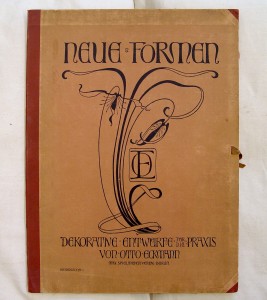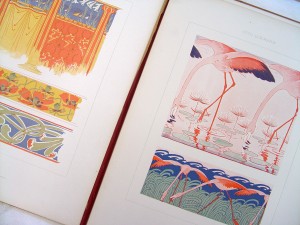Arnold Lyongrün. Neue Ideen für Dekorative Kunst und das Kunstgewerbe. Berlin: Kanter & Mohr, [n.d.].
Neue Ideen für Dekorative Kunst und das Kunstgewerbe is part of the Martin S. Kermacy Collection. Martin Kermacy was a professor at the Architecture School at UT from 1947-1983. The collection reflects an interest in the Vienna Secession and Jugendstil. According to Oxford Art, Arnold Ernest Lyongrün falls into the latter art movement.
Lyongrün created of a series of twenty-four monochromatic plates of blues, greens, and browns. Each plate mixes natural motifs of various species of plants and animals, whether real or fantastic, with human figures and stylized decorative patterns. The layout of the plates appears symmetrical; however, upon closer observation the decorative patterns are in conflict with the perceived symmetry. Lyongrün invites careful study of his motifs. What the eye initially takes in as pattern yields many delights and surprises. Looking upon the plates reminds me of the Book of Kells or other similar medieval manuscripts, though the style and intent are different. It will be quite difficult to choose which plates to share!
“LYONGRÜN, Arnold Ernest.” Benezit Dictionary of Artists. Oxford Art Online. Oxford University Press, accessed September 4, 2014,http://www.oxfordartonline.com/subscriber/article/benezit/B00113028.


